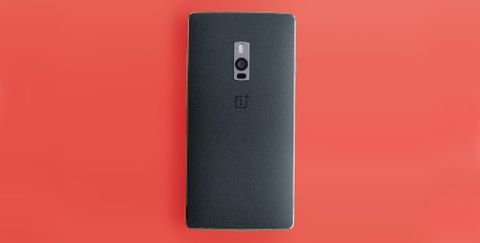IT Pro Verdict
Despite some flaws, not least of which is the annoying purchasing process, OnePlus has come up with a great phone of class-leading value: a real achievement.
Pros
- +
Excellent value; Large, natural-looking screen; Decent camera; Handy fingerprint scanner
Cons
- -
Non-expandable storage; Gets a little warm; Unsophisticated HDR mode; There are bugs to squash
OnePlus is a small smartphone maker taking on more well-known brands with a few clever business ideas. Side-stepping standard distribution channels and most forms of traditional advertising have let it sell the OnePlus 2 Android phone for as little as 199 ex VAT. That approach, plus an injection of viral marketing, has helped it earn a huge following for such a small company.
Latest news
14/03/2016: The OnePlus Two had a software update, enabling RAW photography support.
The update brings the OnePlus Two's custom Android software OxygenOS up to version 2.2.1 and aside from the new camera feature consists primarily of bug fixes affecting issues such as Bluetooth, roaming and Ultra SIM compatibility.
The addition of RAW support is likely to be very popular indeed among professional photographers. The image format is used in point-and-shoot DSLR cameras and captures a full picture of what the image sensor registers, with no added compression.
This means that RAW photos are much larger than regular JPEGs, but also packed with much more detail, and can be used for high-quality photo-editing.
Ordering
The OnePlus 2 has already reeled in two million requests to buy. It's an awkward phrase, but OnePlus doesn't allow traditional pre-orders, using a drip-feed invite system instead. Buyers have to beg to get hold of one.
Despite this, interest has bloomed rapidly because the OnePlus 2 has specifications largely in-line with phones around twice the price. With the invite system now abolished for the OnePlus Two, consumers are now free to get their hands on one as soon as they want.

Price, performance and responsiveness
Remarkably for such a cheap phone, the OnePlus 2 has a Snapdragon 810 processor, Qualcomm's flagship eight-core chip. The OnePlus 2 is easily the cheapest phone we've seen to use this processor.
It's a clear sign the OnePlus 2 wants to be seen as a credible alternative to flagship phones such as the Samsung Galaxy S6, LG G4 and HTC One M9, rather than mobiles closer to its price. OnePlus itself calls the phone the "flagship killer", typical of the company's bragging voice.
General performance is excellent, a definite match for the lead phones of the big names. The only issue is that, like most other Snapdragon 810 phones, the OnePlus 2 tends to get fairly warm even under light workloads. However, in our experience, the phone never got worryingly or uncomfortably hot.
The OnePlus 2 also uses DDR4 RAM, something only a few top phones like the LG G Flex 2 and Samsung Galaxy S6 have used to date. While it offers no significant performance benefits over a well-optimised phone using DDR3 at present, it should help maintain speed and responsiveness if the phone receives future Android upgrades.

There are some minor glitches in the OnePlus 2, but they seem to stem from launch bugs rather than more serious resource management problems that can turn into long-term headaches. For example, the OnePlus 2 uses a custom camera app, and both the image preview and the digital zoom were slightly slow and glitchy. It's nothing a software update can't sort.
We reviewed the 64GB storage, 4GB RAM version of the OnePlus 2, which costs 240 ex. VAT. A 16GB storage, 3GB RAM edition is coming soon for 199 ex. VAT. Unless OnePlus has fouled up the memory management, this should have a near-identical performance to the 4GB variant.
Since the OnePlus 2 doesn't have a microSD slot, internal storage is the most important difference between the two for any prospective buyers.
The OnePlus 2's fingerprint scanner sits under the Home' soft key, requiring only brief contact, not a swipe, to unlock the phone. Its speed and accuracy are very good, comparable with the fingerprint reader found on the Samsung Galaxy S6. It only struggles when asked to deal with a wet finger, typical of a capacitive module. According to OnePlus, the tokenized fingerprint data never leaves the phone, but otherwise didn't state where on the phone this data is stored.
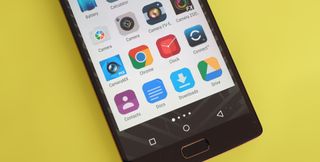
Conveniently, the OnePlus 2 has a mechanical-feeling three-way switch on the side that turns on Silent mode or lets through priority notifications only. It's a very neat and useful extra that comes in handy during meetings and cinema trips alike.
The OnePlus 2 is the first smartphone we've seen to have a USB port that only accepts cables with the reversible USB-C connector. However, it's only the plug that changes here: it's still stuck at USB2 speeds. Until USB-C cables become more widespread, however, you'll need to remember to bring the cable with you as you won't be able to rely on the cable kindness of others.
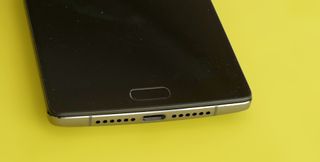
Oddly for an Android phone, there's no NFC and no IR blaster here.
Camera
On paper, the OnePlus 2 has an impressive sounding rear camera with a 13-megapixel sensor with laser focus, optical image stabilization (OIS) and a large 1/2.6 sensor area. All of this should lead to good low-light abilities and speed.
However, despite its use of laser focus, the camera wasn't especially fast to focus in our tests and it was prone to taking out-of-focus shots unless we deliberately selected the point of focus.
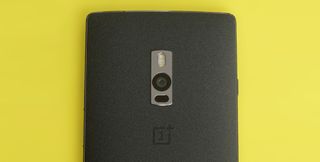
Dynamic range, in general, was good and the OnePlus 2's f/2.0 lens was able to cope with strong light sources without distortion. However, under tricky lighting shots can look a little dull compared to the best of the competition.
The HDR mode was very heavy-handed, often causing radical over-saturation of colours.
For the most part, though, the OnePlus 2 camera is very capable. Its images were sharp and detailed, chromatic aberration was kept to a minimum and low-light shots taken without using the dual-LED flash tended to be reasonably sharp and well-detailed thanks to the OIS system.
Build quality
Although the OnePlus 2 doesn't have a removable battery or a micro SD slot, it still has a removable back panel. The included rear casing has a rough, almost felt-like surface. Alternative covers using various alternative materials such as wood and even Kevlar are available from the OnePlus store. These cost around 20.
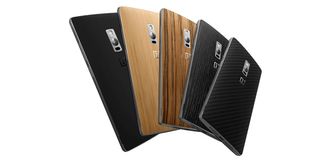
The rear plates are just the outer skin of the phone, hugging the plastic skeleton of the OnePlus 2 tightly, so there's no flexing. This is a fairly expensive-feeling phone, certainly exceeding what we'd expect from a phone at this price.
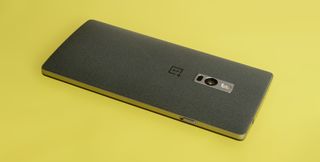
It is rather large, though. A 5.5-inch screen, 175g weight and 9.9mm thickness add up to a phone that can be tricky to use single-handed, especially if you have small hands.
A few modest alterations have been made to the phone's design to try to alleviate this. There's the ability to double-tap the screen to wake the phone, instead of reaching for the power button. There are also various shortcut gestures you can use when the screen is off, such as drawing an O' onscreen to launch the camera, drawing a V' to turn on the flashlight or tapping with two fingers simultaneously to pause music. These are moderately useful, but if you don't like any or all them to then you can turn each gesture off one-by-one.
Battery life and screen
Left to play a 720p video on loop, the phone lasted 11 hours 45 minutes which is a good result. When used more generally for web browsing, snapping the odd photo and music playback, the OnePlus 2 lasted 26 hours without the aid of any battery-saving measures.
It comfortably outlasts the HTC One M9 and LG G4. Even so, the Samsung Galaxy S6 appeared to last longer when used very lightly, possibly due to its 14nm processor architecture and software optimisations.
The OnePlus 2's 5.5-inch screen has a 1080p resolution. Although this isn't as high as the resolutions of some other phones, the 400ppi pixel density still provides very good sharpness at normal viewing distances. The resolution is more than enough.
The IPS screen's image quality is very good with natural-looking colours and reasonably deep blacks, avoiding the oversaturated looks typical of phones with AMOLED screens.
Android
While the OnePlus One launched with the open-source CyanogenMod user interface running on top of Android, the OnePlus 2 uses the OnePlus-made Oxygen interface instead.
Oxygen is similar to CyanogenMod. Both run on top of Android 5.1 Lollipop and avoid the often gaudy, flashy and gimmicky features of other Android overlays in favour of customisations that let power users tweak exactly how the phone operates.
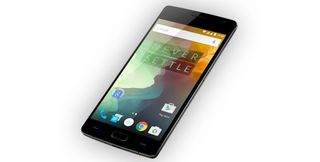
These include options for switching the back/multitask soft keys around, changing the colour accent in the menu system and choosing whether to use the Android hardware buttons or on-screen soft' buttons instead.
Almost all of the OnePlus 2's software extras are easily ignored if you don't want them as they're nestled in the phone's Settings menu. The one part of Oxygen that's very noticeable is Shelf. It sits where BlinkFeed lives on HTC One series phones or where Google Now is in vanilla Android - to the left of the left-most home screen.
Shelf is automatically filled with your most frequently accessed contacts and apps. You can also add any widget to this scrolling list. It might be useful for say novices, but probably less so for Android veterans who've spent a lot of time fine tuning their Android home screens.
Conclusions
Limited availability means the OnePlus 2 will never be truly disruptive in the way the original Moto G was when it arrived in 2013. However, the effort that goes into simply buying one of these phones is warranted. The OnePlus 2 is, overall, a high-quality and thoughtfully design phone that's a great value alternative to far more expensive Android phones. The only real alternative at this price is the almost equally matched Honor 7. This belter of a phone is easier to buy, although it's only available from Three at the moment.
Verdict
Despite some flaws, not least of which is the annoying purchasing process, OnePlus has come up with a great phone of class-leading value: a real achievement.
Processor: 1.8GHz Qualcomm Snapdragon 810
GPU: Adreno 430
Memory: 4GB RAM DDR4
Storage: 64GB or 16GB on-board, non-expandable
Connectivity: 802.11b/g/n/ac Wi-Fi, Bluetooth 4.1, 4G
Ports: USB-C 2.0, headphone jack, 2x nano SIM
Dimensions: 151.8x74.9x9.9mm (HxWxD)
Weight: 175g
